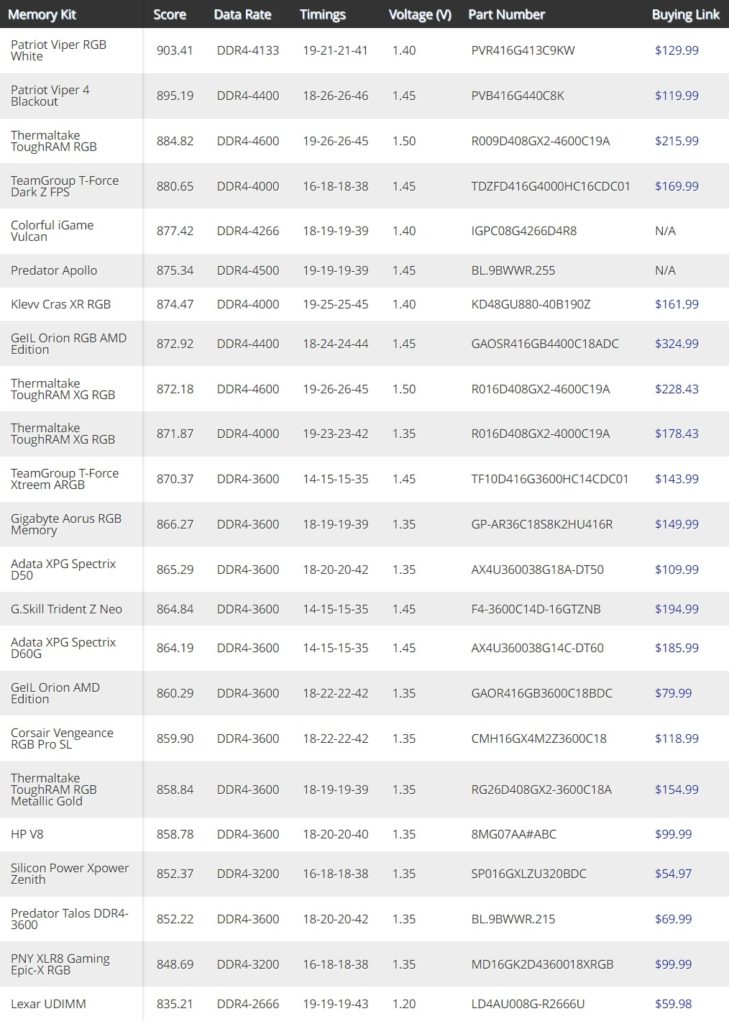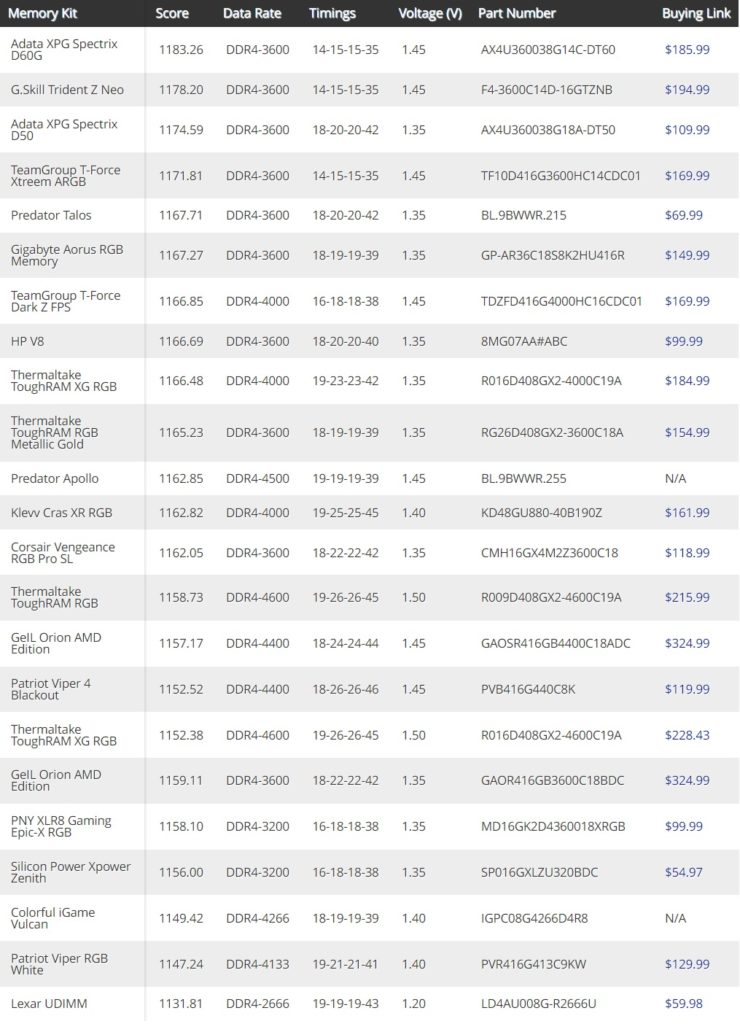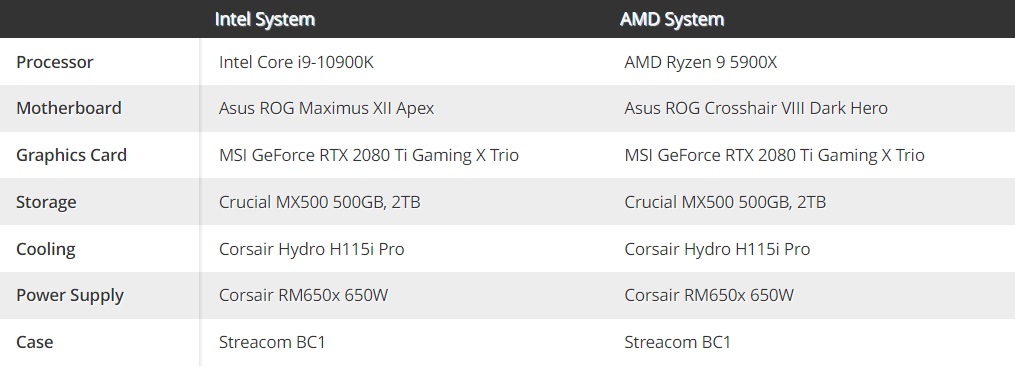RAM Benchmark Hierarchy: Fastest DDR5, DDR4 Memory Kits for AMD and Intel

RAM (Random Access Memory) is often overlooked, but our RAM benchmark hierarchy will help you find the fastest memory kit for your system. Memory is one of the most important pieces of hardware of any system after all. The right or the wrong memory kit has a big impact on your system’s overall performance in gaming, productivity, and (if you don’t have enough of it) overall sluggishness. You can always reference our Best RAM list to find the best deals on memory.
Companies regularly release new memory kits with different speeds, timings, capacities, and ranks, making the process of sifting through seemingly endless models surprisingly time-consuming. Our RAM benchmark hierarchy aims to provide you with a simple database that ranks the best memory kits on the market based on pure performance.
To keep the ranking as objective as possible, we use a geometric mean of our memory benchmarking results and discard the intangibles, like aesthetics and overclocking headroom. We’ve got those details in the individual RAM reviews. Furthermore, we suspect that many of you would value performance over anything else. However, the geometric means don’t always tell the whole story: If you’re looking for performance in a specific workload or for gaming, we recommend taking a look at the full review of the memory kit you have in mind.
The score is a result of the geometric mean from our RAM benchmark suite that includes scripted and real-world tests for Microsoft Office, Adobe Photoshop, Adobe Premiere, Cinebench R20, Corona benchmark, 7-Zip compression and decompression, Handbrake x264 and x265 conversion, LuxMark, and Y-Cruncher.
For the sake of simplicity, we’ve separated the memory kits into different categories according to their densities. We ranked the memory kits for each capacity from best to worst for both Intel and AMD systems.
The score on our hierarchy may differ slightly from the geometric mean in the individual review. The discrepancy is because we strive to provide you with results on the most recent and relevant Intel and AMD platforms. Keeping the metrics in the table as up-to-date as possible involves retesting every single memory kit on the list when there’s been a substantial change in either of our test systems, such as a new processor, motherboard, or graphics card (or even new firmware revisions), just to name a few.
Memory pricing is very volatile. We’ve restrained ourselves from providing a price-to-performance value since it would only capture the pricing for one static moment in time, and memory pricing fluctuates far too much for that. That means that while you can see up-to-date pricing listed in each table below, the performance measurements don’t take that pricing into account.
If you’re split between two particular kits, it’s easy to evaluate the options on your own by dividing the real-time pricing by the geometric mean. Obviously, you’ll want the lowest value possible, as a lower number represents more bang for your buck.
BEST RAM FOR INTEL SYSTEMS
Best 16GB (2x8GB) DDR4 Memory Kits for Intel Systems

Best 32GB (2x16GB) DDR4 Memory Kits for Intel Systems

Best 64GB (2x32GB) DDR4 Memory Kits for Intel Systems

BEST RAM FOR AMD SYSTEMS
Best 16GB (2x8GB) DDR4 Memory Kits for AMD Systems

Best 32GB (2x16GB) DDR4 Memory Kits for AMD Systems

Best 64GB (2x32GB) DDR4 Memory Kits for AMD Systems

PROCESSORS AND OFFICIAL SUPPORTED MEMORY FREQUENCY
Once upon a time, the memory controller resided on the motherboard itself. As processors and motherboards evolved, chipmakers eventually moved the memory controller onto the chips. Therefore, Intel and AMD specify the official supported memory frequency that’s supported on each generation of their processors. Unless you have a very good sample, drifting far away from the supported frequency will require manual tweaking to get the memory to play nice with your processor. For the best plug-n-play experience, you should pick up a memory kit that doesn’t surpass the supported frequency.
There are two important things to take into account if you want to run memory that’s faster than the official specification for your processor. For starters, the quality of your processor’s IMC (integrated memory controller) determines if it can handle high-speed memory. Since no two processors are equal and you can’t judge a chip’s IMC until you test it, you’re at the mercy of the silicon lottery.
Secondly, you need to ensure that the motherboard supports the frequency of the memory kit that you have your eyes on. A quick trip to your motherboard’s user manual or product page should give you the information that you need. Furthermore, the motherboard’s memory QVL (Qualified Vendors List) is very helpful as it’ll tell you whether a specific memory kit has been tested and validated on the motherboard. But remember that your chip’s IMC still plays he bigger role.
If you’re unsure of the memory frequency that your processor supports, we’ve provided the different standards for the last few generations of AMD and Intel processors.
AMD Desktop Processors

AMD’s existing Zen 2 and Zen 3 processors arrive with native support for DDR4-3200 memory modules right out of the box. As you are well aware, Ryzen 3000 puts up the best performance when the Infinity Fabric clock (FCLK) is in sync with the memory clock (MCLK) in a 1:1 ratio. Therefore, it’s important to bear in mind that asynchronous operation introduces a latency penalty. The majority of Ryzen 3000 processors can operate with a FCLK up to 1,800 MHz or DDR4-3600.
Ryzen 5000 follows the same guidelines in regards to the FCLK and MCLK. However, the really good samples can support a 2,000 MHz FCLK, which opens the door to leverage DDR4-4000 memory without any performance hit. For more information on the impact of memory frequency, capacity and ranks on Ryzen 5000’s performance, see our latest Ryzen 5000 RAM guide.
AMD’s Zen 4 (Ryzen 6000) processors have been rumored to support DDR5 memory. There is still no concrete date on when the chipmaker will release Zen 4 but the current speculation is in the fourth quarter of 2022.
Intel Desktop Processors

Intel has launched the company’s brand-new 12th Generation Alder Lake processors. These are the first consumer chips to support both DDR5 memory and the PCIe 5.0 interface. However, Alder Lake is also compatible with DDR4 memory, and it’ll depend on the motherboard manufacturer to pick the best format for their products.
Intel reworked how the memory works on Rocket Lake. The chipmaker introduced gear ratios in relation to the memory controller and memory frequency, similar to how AMD’s FCLK works. Gear 1 finds both running in a 1:1 ratio, while Gear 2 runs the memory controller at half speed (0.5:1). Alder Lake retains this same mechanic.
Alder Lake arrives with native compatibility with DDR4-3200 and DDR5-4800. Intel 600-series motherboards will either come with DDR4 or DDR5 slots and not both due to the radical change with DDR5’s voltage regulation. By default, Alder Lake processors run DDR5 in Gear 2 mode and DDR4-3200 in Gear 1 mode.
DDR5 memory support on Alder Lake depends on the number of memory slots that are populated. On a dual-slot motherboard, Alder Lake supports DDR5-4800 regardless of the configuration. On standard motherboards with four memory slots, DDR5-4400 is the maximum supported when two slots are filled. Populating the four slots with single-rank or dual-rank memory drops support down to DDR5-4000 and DDR5-3600, respectively.

TEST SYSTEMS

The Intel system is based around the Core i9-10900K (Rocket Lake) processor and Asus ROG Maximus XII Apex motherboard, running on the 0901 firmware. The AMD system, on the other hand, leverages AMD’s Ryzen 9 5900X (Vermeer) processor and Asus’ ROG Crosshair VIII Dark Hero motherboard, which is on the 3501 firmware. The Corsair Hydro H115i Pro is in charge of cooling for both systems. Regardless of the testbed, the MSI GeForce RTX 2080 Ti Gaming Trio is our graphics card of choice for tackling the more intensive graphical workloads.
Our Windows 10 operating system resides on Crucial’s MX500 500GB SSD, while our games are stored on the 2TB unit. The Corsair RM650X 650W provides the necessary power for both our test platforms, meanwhile the Streacom BC1 is the perfect open-air testbench to house all of our hardware.

The latest TrendForce report estimates that DRAM pricing will decrease between 3% to 8% in the fourth quarter of this year. According to the firm’s investigation, DRAM suppliers have more than enough stock for their clients. However, the latter has a surplus of inventory so the demand is smaller. This is music to consumers’ ears since pricing for memory kits should see a significant drop in the upcoming months.